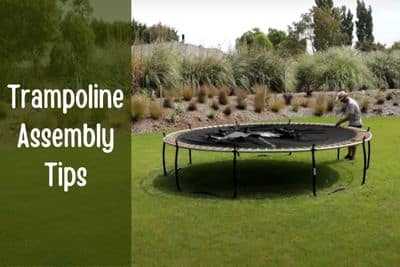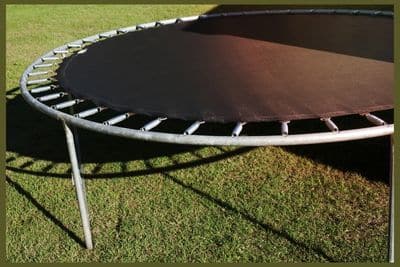Trampoline is a favorite backyard pastime for the whole family. When the boxes of a new trampoline arrive, it’s time to set it up before jumping on it. To put up the trampoline properly, you should learn the right installation first.
But the question arises, ‘Is it difficult to assemble the trampoline’? No, installing a trampoline isn’t very hard; rather, it’s easy if you have the proper tools and know the right tricks. So, how to put a trampoline together? Trampoline assembly includes putting up all the parts together, like the frame, springs, mat, poles, net, etc, one by one.
This article will guide you to set up a trampoline easily. Let’s read the complete trampoline building instructions.
Is It Hard to Put Together a Trampoline? Can I Do It Alone?
You might be thinking about how hard it will be to assemble. Well, take a peaceful breath because it’s not as difficult as you might think. Usually, installing a small trampoline is quite easier compared to the bigger one.
Though building a large trampoline by yourself is a little tough, you can still do it following the manual that comes with the trampoline package. Some of the difficulties that you may face assembling the trampoline alone.
- To handle the weight of bulky parts like the frame, it’s wise to take help from one or two people for safety purposes. You may also need someone’s help to flip the frame before hooking the jump mat and springs.
- Recognizing the proper bolts is quite confusing for the metal frame structure. But if one or two people help you, the task will be easier.
See Also: Tips to disassemble a trampoline
How to Put a Trampoline Together Step by Step?

Here comes the main deal how to assemble a trampoline? The trampoline setup process can be classified into several steps, such as-
- Pre-assembly preparation
- Build the frame first
- Attach the legs and poles
- Hook the mat and springs
- Add a safety pad
- Attach enclosure net
- Add accessories
The trampoline installation method may vary a bit depending on the trampoline type, size, and brand. However, the key steps are almost the same for all.
Step 1: Pre-Assembly Preparation
Preparation is the most important part of putting together the trampoline.
1.1 Read the Manufacturer’s Manual
Each trampoline comes with an instruction manual where you will find the detailed process of installing the trampoline. Most trampoline assembly guidebooks have a step-by-step guide to set up the trampoline perfectly.
Though every brand has its own guide to follow for assembling the trampoline. Read this thoroughly before you install the trampoline. You can also download the manual search on the web with the brand and trampoline model.
Moreover, you can talk with professional trampoline installers or experts if you have any confusion. However, to make your task easier this article will guide you on how to build a trampoline effectively.
1.2 Tools and Accessories
Like installing other equipment, you need some tools to assemble the trampoline. Some of them are, a Phillip head screwdriver, power drill, spanner, Allen key, caulking gun, rubber mallet, spring puller, obviously a pair of gloves to keep your hands safe, and many more.
1.3 Ground Preparation
1.3.1 Leveling the Ground
The trampoline needs to be placed on a flat and smooth surface. If you put your trampoline on uneven ground, it will shake and provide uncomfortable jumping.
This may lead the jumper to a severe injury, so keep the trampoline on a level surface. It will help to get you the perfect bounce you need.
And put some soft materials under the trampoline for extra cushioning. This will prevent damage to the frame and provide a comfortable bounce as well as make the trampoline long-lasting.
1.3.2 Proper Clearance
Placing the trampoline in the backyard is always the best option as it’s always best to put a trampoline in an open space. It decreases the possibility of accidents or severe injuries while landing off the trampoline. For safety have a minimum of 1.5 m clear space surrounding the trampoline and a 6 m height clearance.
See Also: Can you put a trampoline on concrete?
1.4 Lay Out All the Parts
Trampoline parts are delivered in several boxes. After receiving the boxes, unbox them and lay them out on the flat ground. Also, cross-match them with the trampoline manual. You can also sort them to make the setup easier.
If you found something missing or faulty it’s best to call the store or the brand customer care immediately for a replacement. In most cases, they will send the replacement parts soon.
After recognizing all the trampoline parts, let’s begin with the main assembly.
See Also: When to buy a trampoline of the year?
Step 2: Build the Frame First
When you have completed the ground well and have all the necessary tools and trampoline parts ready, it’s time to jump with the main assembly. Start with installing the trampoline frame first.
The frame parts are in front of you. Put all the frame rods in shape and start joining them with the T-sockets. T-sections also help to join the pole legs with the frame.
You have to push the frame rods inside the T-socket and complete the whole circle. If the trampoline is any other shape, this will give you the basic on-piece structure of that shape.
It’s always recommended to assemble the frame upside down, as it will be easier for you to attach the legs. This’ll allow you to build the trampoline alone. Otherwise, you will need to volunteer to hold that heavy frame while you attach the legs.
And definitely, it will be quite tough to hold that frame for such a long time. So, it’s best to install it upside down and then flip it over.
If the trampoline frame does not go together, apply extra force to bring the ring closer to complete the attachment.
See Also: Trampoline cleaning tips
Step 3: Attach the Legs and Poles
After attaching the frame properly, start joining the legs into the T-socket. This will give the complete shape of the trampoline foundation.
Though attaching legs with a trampoline frame is an easy task, you may still face some difficulties. For any issue, you can use the rubber mallet to line up the frame holes.
Now take the bolts or screws that came with the frame and put them on the holes for securing the frame. Your hand should be enough to secure the bolts, but if it’s not, you can use the Phillips head screwdriver to work on it.
For faster, you can also use the power drill instead of a screwdriver to secure the screws or bolts. Be a little hard on the screws as not a single one should be loose. One single loose screw can make the frame wonky or bend which could be hazardous.
If the trampoline frame is standing on its legs without dangling it means you did a good job. But if you feel the legs are shaking or attached oddly, you have to redo the whole frame assembly. And do it right this time.
See Also: Easy fixes to trampoline pole
Step 4: Hook the Mat and Springs

Now comes the trickiest yet tough part of the trampoline setup i.e. springs. Here you will need both strength and math to complete the matt and spring put up. First, flip over the frame to turn it into its original shape and stand it on the legs.
But avoid flipping the frame without others’ help as your backbone might not be too strong to take the full weight of the trampoline. However, if you and the assistant hold the trampoline from two different sides, it’ll be up it in the air and flip over easily.
You will find hooks on the mat and the squeezy springs. Here you have to do a little math. Tell your partner to stand exactly opposite the frame and hold the mat precisely. Make sure to use your gloves, rubber mallet, and spring puller for this mat assembly.
Your bare hands won’t be able to attach the springs and your skin can peel off in the battle with these tight-squeeze springs. So, use the spring puller to pull the springs and use the rubber mallet to snap it inside the frame.
First, join the exact opposite spring hooks together in the frame. Then go to the 90-degree angle of the first two springs and attach the exact opposite springs together. As four foundation springs are attached, you can take it forward alone.
Now leave one hook and again attach the exact hooks one by one. Keep doing the spring attachment until all the springs are attached. Don’t miss a single spring, or don’t attach it in the wrong hook.
After attaching springs and mat, the main part of the trampoline setup is done. But don’t rush to jump on it. Add some safety items now.
Step 5: Add Safety Pad
The Spring pad is an important safety accessory for the trampoline. Most trampoline packages come with safety padding. It helps to cover the metal frame and springs with soft pads to make sure the jumper accidentally falling on the frame or spring doesn’t get hurt.
You will find Velcro or ropes on the padding to attach it to the trampoline frame. Some trampolines may also come with metal hooks for attaching the pads. However, there should be some holes too for attaching it with the legs.
Just lay over the pad over the springs. Add the securing Velcro or hooks, and another step of your assembly is done.
Step 6: Attach Enclosure Net
Though it is an optional part, but should be a necessary one for ensuring the kids’ safety. Some brands already sell enclosure nets with trampoline packages. In case you didn’t get one, just buy it from the same store.
For setting up the safety net, first, take the bungee loops and attach them to the net bottom and frame. Then attach the net post to the frame after decking them with soft foam sleeves. Once the posts are put in the place secure them with screws or bolts as you did with the legs.
Now use the given ties or fittings that came with the net to attach the net top to the poles. Some net enclosures may also come with a top-ring (O-ring) setup where you just have to snap the bungee loop to attach to the posts.
Even some enclosure nets also come with attachments that you just have to set with the trampoline frame. Even some nets are placed inside the springs that are directly sewn with mats. VOILA, the trampoline is ready for your bouncing!
Step 7: Add Accessories
Safety is done; now just a few more setups to go. Well, these are also fully optional, but you can use them to ensure a better experience and long-term use. First, anchor the trampoline legs in the ground with anchor kits, it will ensure your trampoline doesn’t blow away in heavy winds or storms.
For helping your toddler to get on the trampoline, you can also buy a ladder and some fun game attachments like a basketball hoop, slide, volleyball net, light, and so on to make it more interesting.
Here is a trampoline assembly video for the visual learner.
How Much Does It Cost to Assemble a Trampoline?
If you do it yourself, there will be hardly any cost for assembling the trampoline. When you take help from an expert it may cost almost the same as buying the trampoline kit.
For giving you an exact number, an expert will charge you around $100 to $300 based on the trampoline size and other associated things. But in-ground trampoline installations are quite expensive than the regular models.
How Long Does It Take to Set Up a Trampoline?
In general, trampoline installation requires 1 to 5 hours and even more. Some of the prominent trampoline assembly times are shown in the following table.
| Trampoline | Installation Time |
| Mini trampoline or rebounder | 30 minutes to 1 hour |
| 5 to 7 ft | 1 to 2 hours |
| 8 to 10 ft | 2 to 2.5 hours |
| 12 to 15 ft | 3 to 4 hours |
| Extra-large trampoline | 4-5 hours |
See Also: In-ground trampoline installation tips
Frequently Asked Questions
After knowing the basic things, you may have more questions about trampoline assembly instructions. Don’t worry; here, I’ll cover some of them.
a) Is there any trampoline assembly service near me?
Ans: There are many professional trampoline installers near you who provide trampoline build services. Their costs may vary depending on their skills. Nowadays, some trampoline manufacturers like Vuly, Springfree, etc, have trampoline installation packages.
You can search on the web with your location to find the best trampoline assembly service near you. Airtasker.com enlists 10 top trampoline assemblers.
b) Does installing a mini trampoline differ from the large model’s process?
Ans: Installing a mini trampoline and rebounder is quite easier compared to the large models. Usually, smaller the sizes, the lesser the time you require, but the steps are almost the same.
See Also: Indoor trampoline install & dismantle tips
c) Is the trampoline put-up method varying with trampoline shape?
Ans: No, the main steps of trampoline assembly are almost the same for any shape trampoline. But complex shapes require more time and effort to assemble them. For example, rectangle trampolines are quite more time-consuming than round models.
See Also: Tips to put together a trampoline in the desert
Conclusion
Coming to the end of the trampoline setup guide, I hope you have gotten a clear overview of how to install a trampoline easily. Though for different brands and shapes, the steps or process may differ a tad. But it will be done easily if you follow the instructions.
Remember, following the guideline is the key while assembling a trampoline. Also, maintain safety while setting up the trampoline and keep children and pets away to avoid uninvited scenarios.
After putting the trampoline together double check all the steps. And when it is done properly allow your kids to bounce on the trampoline. Happy trampolining!

Robert is a trampoline and rebounder trainer with a passion for blogging. He discovered his love for trampolining at a young age, when his father gifted him his first trampoline at the age of 9. Over the years, Robert has honed his skills and knowledge in the field, and now uses his expertise to train others.
Besides, helping fitness enthusiasts in the gym, Robert is very eager to share his knowledge and experience regarding trampolines and rebounder exercises with the readers of picktrampoline.com. He will share all you need to know about trampolines and rebounders in this blog. Get his tips on trampoline and rebounder!

Thanks for sharing this helpful installation tips!